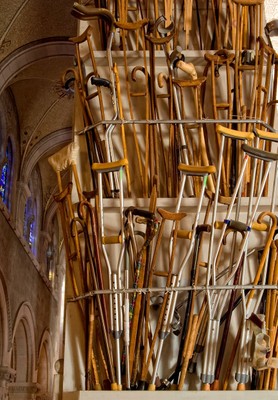 I broke my ankle three weeks ago. And no, it wasn’t undertaking some spectacular athletic feat. It was a simple trip and fall at home. But now that I’m on crutches, I’ve had the opportunity to see what it’s like to be disabled.
I broke my ankle three weeks ago. And no, it wasn’t undertaking some spectacular athletic feat. It was a simple trip and fall at home. But now that I’m on crutches, I’ve had the opportunity to see what it’s like to be disabled.
I am fortunate, obviously, because my bones will heal, and soon I’ll be up and about. But along with a new found gratitude for simply being able to get up and answer the door, I’ve also found another reason to love my dense compact neighborhood of Capitol Hill in Seattle. It turns out that my part of the world, one of the most densely populated neighborhoods in the Northwest, is pretty easy to get around on crutches. While my neighborhood is considered a “walker’s paradise” by Walk Score’s measure, it is also conducive to getting around in other ways, including on crutches. Why? It’s pretty simple; everything in my neighborhood is close by.
When I looked into whether there had been studies, or reviews of studies, about public space and accessibility for people with physical limitations, almost all the work was about the design of sidewalks, doorways, and transit. The obstacles for a disabled person using a walker, wheel chair, or cane are pretty obvious: high curbs, lack of ramps, and poorly placed street furniture—benches, planters, and kiosks. The typical solutions are also obvious: places to rest or sit, intervals between posts and signage, appropriate width and passing space, and the elimination of protruding objects and steep edges. Taking a trip on crutches, these were the kinds of things that I really began noticing all over my neighborhood. Even a subtle difference in the grade of a staircase could be the difference between mild and major exertion.
But besides these hazards, and the obstacles of sloppy sidewalk design and maintenance, it’s the distance between things that matters most. When I put my address into Walk Score it scored a 92 for walkability. Walk Score defines a walkable neighborhood as having:
- A center: Walkable neighborhoods have a center, whether it’s a main street or a public space.
- People: Enough people for businesses to flourish and for public transit to run frequently.
- Mixed income, mixed use: Affordable housing located near businesses.
- Parks and public space: Plenty of public places to gather and play.
- Pedestrian design: Buildings are close to the street, parking lots are relegated to the back.
- Schools and workplaces: Close enough that most residents can walk from their homes.
- Complete streets: Streets designed for bicyclists, pedestrians, and transit.
Anything I could possibly need or want is within about a block or two, which is about the reasonable limit to crutch and not be completely exhausted. The paved surfaces are not always the best, but it doesn’t matter as much because I don’t have to cover very much of them. And sheltered bus stops—with multiple routes—are also easily accessible; extending the distance a person with physical limitations can travel.
I can’t drive in my current condition even if I wanted to, which is the case with many disabled people. In some neighborhoods like the one where I grew up in Albuquerque, New Mexico (Walk Score 49—car dependent) that could be a kind of death sentence.
So don’t break your ankle. But if you do, you’re best off living in a compact community. Along with the benefits for surface water, the climate, energy efficiency, health, and transportation we can add another benefit of dense urban form: better accessibility.
Photo: “Testament of Faith,” Purchased from Bigstock








Alex
Hi Roger, interesting article. Coincidentally, my wife works with your wife, and my wife was recently on crutches after having knee surgery in April. We found cases where Seattle was not particularly friendly to our situation. For example, there are metal covers (for water mains, etc.) in the middle of sidewalks, and when wet your crutch will dangerously slip right off. Also, there’s no good place to stop the car when dropping off a person on crutches in a lot of places in Seattle. Twice I was told to move when picking up my wife at work, and she was forced to crutch painful extra distances. Mostly I’m just venting, I don’t think there are any easy solutions here, except for maybe slip-free covers for sidewalk openings.